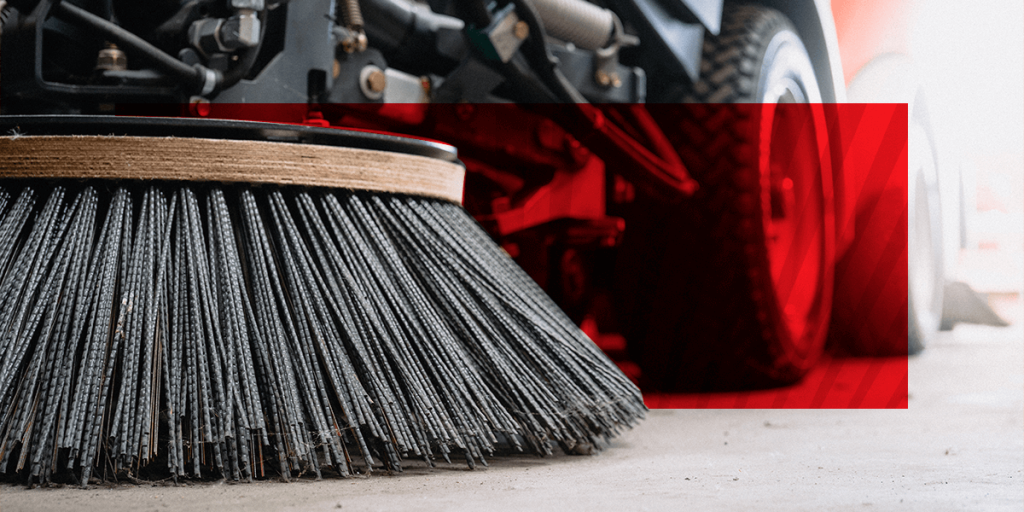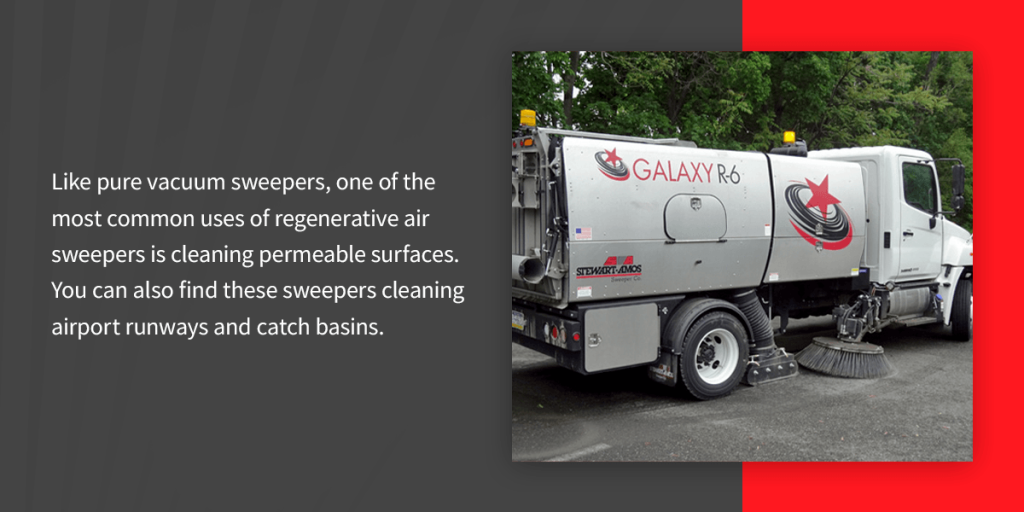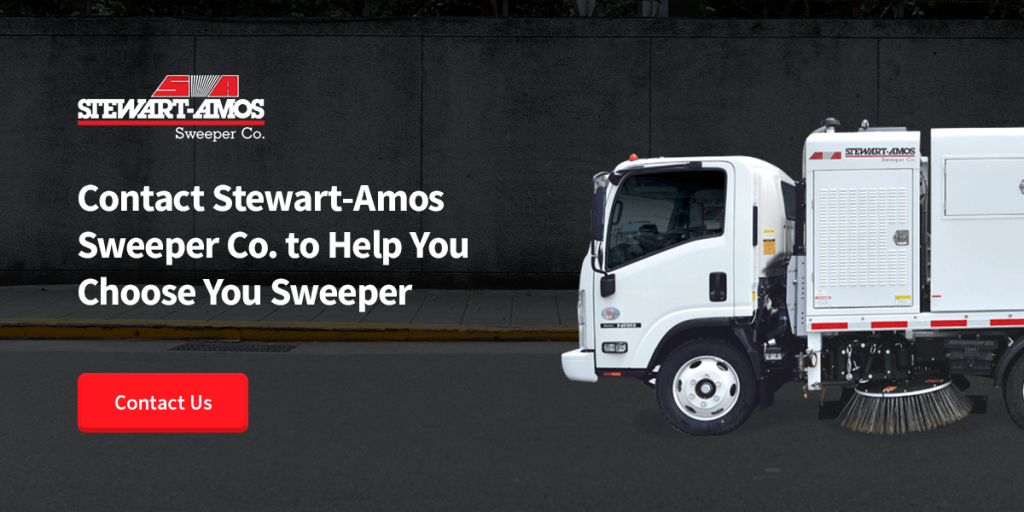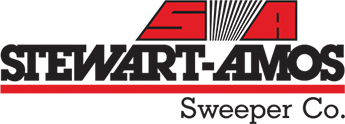Street sweepers are vital pieces of equipment for cleaning parking lots, roads, runways, gutters, construction sites and pavements. There are three main types of street sweepers — mechanical broom sweepers, regenerative air sweepers and vacuum sweepers. Because they have been around the longest, mechanical broom sweepers are the most common type of street sweeper used today. However, vacuum and regenerative air sweepers are gradually growing in popularity.
Vacuum and regenerative air sweepers use suction to remove debris and dirt from surfaces. They are well suited to cleaning permeable pavements and for situations where air pollution is a concern. While they both use suction, regenerative air and vacuum sweepers have a few differences that impact their use.

Vacuum Sweepers
Pure vacuum sweepers function similarly to household vacuums on a much larger scale. A single outlet sucks in the debris from the surface. This outlet is usually on one side of the sweeping head that directs waste toward the vacuum opening. The sweeper then blows the air out of the opposite side or back of the machine. Most pure vacuum sweepers are designed to clean a width of about three feet, where most debris usually collects on a road.
Vacuum sweepers are usually better than mechanical broom brushes in removing smaller, finer particles from surfaces. However, they also emit a large amount of these particles when they release the air. Many newer models of vacuum sweepers are starting to incorporate water systems to help control the dust and other fine particles the sweeper emits. They spray the water onto the debris as the vacuum pulls it in or onto the full hopper to stop the particles from leaving the system.
Municipalities, construction teams and contractors use these sweepers to clean streets and industrial buildings.
Advantages
There are a few advantages to using pure vacuum sweepers, including:
- Thorough cleaning: A vacuum sweeper can pick up large pieces of trash and small dust particles.
- Less dust: Vacuum sweepers produce less dust than mechanical sweeping methods, even in systems without water suppression systems.
- Versatile: They can effectively clean wide, narrow, smooth and uneven paths. Pure vacuum sweepers are also well-suited to cleaning permeable pavements, ensuring they remain unclogged.
- Easy to maintain: Vacuum sweepers have fewer moving parts than mechanical sweepers, making them easier to maintain.
- Powerful: Pure vacuum cleaners have a strong suction force, allowing them to lift heavy trash or debris stuck in small spaces.
Disadvantages
There are a few drawbacks to using pure vacuum sweepers. While most vacuum sweepers use water suppression systems to control dust and particles entering and leaving the machine, they can re-release a considerable amount of particles and dust into the air. Many cities and industries are trying to limit air pollution, so it is crucial to use vacuum sweepers carefully.
Another significant drawback of vacuum sweepers is their narrow and limited cleaning path. Vacuum heads tend to be about 8 inches and rely on brooms and brushes to sweep debris and trash toward the vacuum head. These two elements mean pure vacuum sweepers have a narrower cleaning path than regenerative air sweepers. Their use is also limited to areas where they can use the brushes.
Regenerative Air Sweepers
Unlike pure vacuum sweepers, regenerative air sweepers use air in a closed circuit to displace and suck up debris on various surfaces. The carefully controlled and directed air blasts dislodge debris, making it easier to suck into the machines. The machine then uses the air it pulls in with the waste to shift the next section of trash.
These machines also use water to prevent dust from escaping the hopper and into the air with the next blast. Some models use a dust separator on the air leaving the hopper as an extra step to reduce the number of fine particles the blasts release.
Regenerative air sweepers have a wider cleaning path and can pull up large debris and fine particles. The closed air circuit reduces air pollution, making them ideal for industrial, commercial, residential and municipal cleaning in areas with air pollution regulations. Like pure vacuum sweepers, one of the most common uses of regenerative air sweepers is cleaning permeable surfaces. You can also find these sweepers cleaning airport runways and catch basins.

Advantages
There are several advantages to using regenerative air sweepers, including:
- Versatility: As regenerative air sweepers rely on blasts of air to dislodge debris before vacuuming, they can clean hard-to-reach areas. They can also handle most types of rubbish, from large to small items and microscopic particulates. Attachments like hand hoses and gutter brushes mean air sweepers can also clean a wider variety of environments.
- Environmentally friendly: The closed-air circuit traps more particles in the system, ensuring less dust escapes back into the environment.
- Wide cleaning path: Regenerative air sweepers usually have vacuum heads about 14 inches wide. These larger heads allow them to clean wider paths and pick up larger debris than pure vacuum sweepers. They can clean the whole lane or pavement rather than only one side.
- Easy to maintain and cost-effective: With fewer moving parts, regenerative air sweepers are more affordable to maintain and operate than vacuum or mechanical sweepers. As a result, they are well-suited for everyday street sweeping and routine cleaning programs.
Disadvantages
There are only a few drawbacks to using regenerative air sweepers. While these sweepers have a strong suction force, they cannot handle heavy-duty cleaning as easily or well as mechanical sweepers. This limitation makes them unsuitable for cleaning up street millings and big spring clean-ups. Regenerative air sweepers also work best on straight and even surfaces. As a result, they should not be used on uneven surfaces or roads with potholes.
Contact Stewart-Amos Sweeper Co. to Help You Choose Your Sweeper
Knowing which type of street sweeper to use can be challenging. Every environment is unique, with different kinds of debris and surfaces. You must choose the right sweeper that will provide the best possible cleaning.
Stewart-Amos Sweeper Co. has been providing high-quality street sweeping equipment for over 75 years. We take pride in designing and manufacturing effective regenerative air sweepers that are easy to operate and maintain. Our extensive network of dealers ensures you can always order replacement sweeper parts and get them delivered on time.
If you need help figuring out which type of street sweeper to use, we can help you. Our dealers will work with you to understand your specific cleaning needs and what would work best. You can also organize an obligation-free demo to see our machines in action. Contact us online today or give us a call at 800-482-2302.

